
If you’re having problems with your air conditioner’s condenser, it may be time for an upgrade. Learn about the cost to replace an AC condenser in this guide.
It may be small, but it’s mighty at heating your space


A wall furnace costs between $1,100 and $2,500.
Wall furnaces are priced according to BTU/hour.
A wall furnace provides around 25,000 BTU/hour, a fraction of a forced-air furnace’s output.
This smaller furnace works best in small rooms because it takes a while to heat the space.
Whether you need to retrofit a heating source into an older home or install a furnace unit in a smaller space, a wall furnace is an energy-efficient option. Offering some compelling benefits like low maintenance and relatively easy installation steps, a wall furnace can easily replace older units with no problem. Read on to learn more about what wall furnaces are and how they can work for your home.
A wall furnace is a compact unit that attaches to an interior wall of your home, distributing heat through a vent. Heat is generated by circulating air around a chamber. Because of this recirculation, wall furnaces are more effective heaters in smaller units and homes. They also don’t require ductwork to distribute the heated air.
Wall furnaces are powered by natural gas or electricity and need to be hardwired into your home’s electrical system. You’ll want to have a wall heater repair specialist near you or an electrician handle the installation and hookups to run the wall furnace.

A standard new furnace costs between $2,820 and $6,810. Wall furnaces cost slightly less than this average, and the cost of a wall furnace is impacted by the furnace’s BTU (British Thermal Unit) capacity. BTUs measure heat energy. A furnace with more BTUs can heat up a larger space more efficiently. However, higher-BTU furnaces will also cost more.
For example, a 14,000-BTU wall furnace may run you around $1,100 to $1,300, while a more powerful unit that produces around 38,400 BTU per hour averages $2,500.
Get your HVAC system serviced and inspected at least once per year. For extra peace of mind, call in a pro twice annually: once before the hottest months of the year and again before the coldest time of year.
Like most furnaces, wall furnaces benefit from an annual furnace maintenance appointment that includes cleaning and an inspection. This can keep your unit running properly. A heating technician can identify if any repairs are needed to keep everything safe, leak-free, and properly sealed.
In addition, your wall furnace will run better if the burner compartment is cleaned out once a month to prevent lint from building up. You can also wipe down the vents with a damp cloth to remove excess lint and dust. If the furnace needs repairs, the average cost to fix a furnace is around $320.
Wall furnaces can be a great deal in the right circumstances, but they also may be too small to properly heat a space. Here’s a rundown of wall furnace pros and cons.
Size: Its smaller profile and footprint can free up wall space and fit into smaller homes and spaces. This makes it an ideal option for ADU builds and retrofitting older spaces.
Installation: Because it doesn’t need to be hooked up to ductwork, a wall furnace is an easy installation for an electrician or furnace technician.
Air quality: Gasses like carbon monoxide are significantly reduced with a non-combustion heat generator. Plus, it keeps the dirt and dust to a minimum.
Less powerful: Even a unit that can handle 25,000 BTU/hour isn’t going to put out the same amount of heat as a traditional furnace system (around 80,000 to 100,000 BTU/hour).
Longer time to heat a room: A smaller, less powerful unit means that it takes more time to get the room temperature up. You’ll likely have to run the wall furnace for longer to achieve the desired results.
From average costs to expert advice, get all the answers you need to get your job done.

If you’re having problems with your air conditioner’s condenser, it may be time for an upgrade. Learn about the cost to replace an AC condenser in this guide.

Whole-house humidifier costs vary based on the type and size of the unit, along with other factors. The price might be worth it for people living in dry regions.

The average boiler installation cost depends on size, system type, and other factors. Keep reading to learn the cost of a new boiler.

Need to purchase a new gas furnace but aren’t sure which type is right for your home and needs? Taking a little bit of time to research furnaces to see which option is right for you can save you money over time. Here’s a look at five furnace types.

Baseboard heater covers can endure a lot of wear and tear, but eventually you’ll want to replace them. Here’s the best way to switch out baseboard heater covers.

Wondering who to hire for swamp cooler installation? Learn when to call an HVAC contractor, electrician, or handyperson, and what to expect.